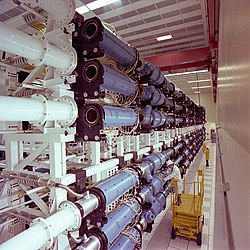This article has multiple issues. Please help improve it or discuss these issues on the talk page. (Learn how and when to remove these messages)
|

Big science is a term used by scientists and historians of science to describe a series of changes in science which occurred in industrial nations during and after World War II, as scientific progress increasingly came to rely on large-scale projects usually funded by national governments or groups of governments.[1] Individual or small group efforts, or small science, are still relevant today as theoretical results by individual authors may have a significant impact, but very often the empirical verification requires experiments using constructions, such as the Large Hadron Collider, costing between $5 and $10 billion.[2]
- ^ "big science" Archived 23 April 2009 at the Wayback Machine, Merriam-Webster
- ^ Evans, Lyn; Bordry, Frédérick; Liyanage, Shantha (30 April 2024), Liyanage, Shantha; Nordberg, Markus; Streit-Bianchi, Marilena (eds.), "A Machine with Endless Frontiers: The Large Hadron Collider (LHC)", Big Science, Innovation, and Societal Contributions (1 ed.), Oxford University PressOxford, pp. 56–87, doi:10.1093/oso/9780198881193.003.0004, ISBN 978-0-19-888119-3, retrieved 8 June 2024